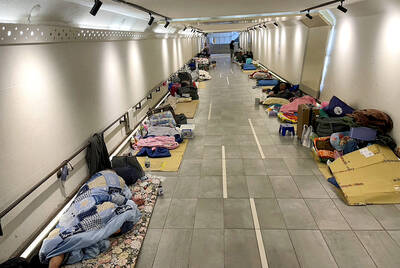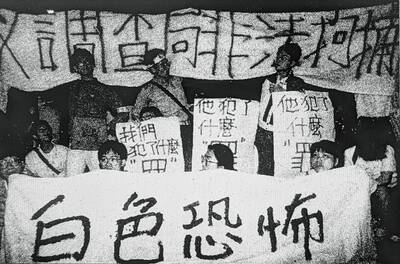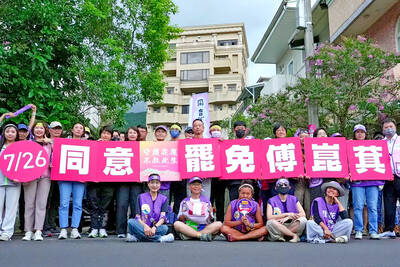After a long courtship over the telephone, Asma Ahmed, a painter in Karachi, Pakistan, married her fiance, Rafi-uddin Shikoh, a business consultant in New York, in a bicontinental wedding by Webcam. When the new bride then moved to Queens in 2002, she tried to make herself at home by staking her claim through art.
In Pakistan, Ahmed Shikoh’s work had been sociopolitical, addressing what she saw as the country’s colonization by American fast-food chains, for instance, with paintings like The Invasion, in which swarms of Ronald McDonalds, wearing screaming-red clown wigs, surround a central monument in Karachi.
Here, however, her art turned deeply personal as she grappled with her new identity as an immigrant and, having rarely set foot in a mosque back home, as a gradually more observant Muslim. In her first American paintings, Ahmed Shikoh reimagined the Statue of Liberty in her own image: in a Pakistani wedding dress, as a pregnant immigrant and as a regal mother, baby on hip. Next she transformed the subway map with paint and calligraphic script into an Urdu manuscript that made the city feel more like hers.
Finally, in 2006, after she made the difficult decision to cover her hair, inspired by Muslim-American women who managed to combine faith and a career, Ahmed Shikoh began using the head scarf as a recurring image.
On the surface, Ahmed Shikoh, 31, has little in common with Negar Ahkami, 38, a sleek, raven-haired Iranian-American artist, beyond the wall space that they share in a new exhibition, The Seen and the Hidden: [Dis]Covering the Veil, at the Austrian Cultural Forum in Manhattan. Ahkami grew up in suburban New Jersey, considers herself only “technically Muslim” and toys with stereotypical images of exotic Middle Eastern women in her art.
Yet the two are both in their 30s, mothers of small children and emerging artists in the New York area. They are both exploring their identities as refracted through their backgrounds in the wake of 9/11. And they are both working to create a new kind of Islamic art that is modern, Westernized and female-centric. “As women artists of Muslim descent, Asma and Negar are both trying to discover who they are, to look at themselves and their heritage and to get beyond stereotypes,” said David Harper, a curator of the Austrian exhibition. “What’s so interesting is that they present two such very different ways to examine the subject from American soil.”
The Hidden and the Seen, which runs through Aug. 29, features 15 artists, 13 of them women, of whom Ahmed Shikoh and Ahkami are the only full-time US residents. The exhibition is a partner event of the Muslim Voices Festival organized by the Brooklyn Academy of Music, Asia Society and New York University’s Center for Dialogues.
In this exhibition Ahmed Shikoh and Ahkami seek to humanize the individuals. Ahmed Shikoh’s approach is deeply earnest. Her installation, Beehive, is a cardboard honeycomb whose cells are stuffed with the colorful scarves that she collected from scores of Muslim-American women who also sent messages — “I ran the 10k Bolder Boulder and wore this scarf” — that annotate this intentionally rough-hewn work.
In contrast, Ahkami’s piece is playful, acerbic and polished. It consists of eight nesting dolls sumptuously repainted as Persian Dolls, in brilliant colors with gold faces. The outer doll is stern, with a thick unibrow, in full black chador. The ever smaller dolls within wear Chanel head scarves or cocktail dresses or, as with the tiniest, nothing at all but curves.
“I have always struggled with the images of humorless, somber Iranian women in full-on black chador,” Ahkami said. “For me these images do not reflect the real Iranian women any more than the images of the harem girls of the 19th century did.”
Ahkami felt angst here too. The child of Iranians who emigrated in the 1960s, she grew up in Clifton, New Jersey, spending what she remembers as magical summers in Iran until the Islamic revolution of 1979. With the hostage crisis, her world split in two, making her feel like the child of a messy, public divorce.
“At a time when I was trying to assimilate, it was very confusing to me,” she said. “I was born here, and suddenly the girl across the street was saying: ‘You never told me you were Iranian. You said you were Persian.’ And I never saw her again.”
A hypersensitive young artist, Ahkami was not stung just by the classmate who mouthed “ayatollah” at her. She hated being made to explain her family in the context of television images that made all Iranians seem like “Death to America”-chanting fundamentalists. She hated the way that the culture she loved was “degraded, demonized and reduced to a cartoon” both here and in Iran.
Years later, with the skills she started learning at 10 at the Art Students League of New York, she would channel those feelings into paintings in which she seized and subverted the cartoonish stereotypes. But then she pushed away from her culture.
She reconnected in the roots-conscious environment of Columbia University in the late 1980s. In art history classes she noticed connections between Western and Persian art that academics dismissed, condescendingly, in her view. She majored in Middle East languages and culture.
Ahkami never stopped making art, though, even when she took “a major detour” by going to law school at Georgetown University. On graduating, she worked first at a white-shoe law firm, then in the legal department of the Museum of Modern Art — during which time she started kissing paper.
With a red-painted mouth, she used her lip prints to fashion affectionate portraits of Iranians wearing head scarves. She called them her Lipstick Revolution series, a tribute to those women who sought to express themselves within the government-enforced hijab, or modest dress, by a dab of rouge here, a flick of mascara there.
As she hit 30, Ahkami decided to leave her job so she could paint full time. Her last week of work was the week of Sept. 11, 2001.
“After that, all these wounds that had never really healed about the Iran stuff came open,” she said. “For about a year I was working from home and not leaving my apartment for days on end. I was doing these depraved cartoony drawings with all these creepy, raw characters and then, separately, these colorful Persian miniatures.”
If Ahkami, a first-generation American, looks back at her homeland with the complexity of an introspective Manhattanite, Ahmed Shikoh, a relatively recent immigrant, looks mostly forward.
“I’ve never felt this happy or this liberated,” Ahmed Shikoh said, standing in the garage of her home in Marlboro, New Jersey, where Beehive was laid out on the floor before the Austrian exhibition opened. Exuding a serene confidence, she glided through her honeycomb as she talked.
In Karachi, Ahmed Shikoh considered women who covered their hair to be relics of the past. Her grandmother had thrown off her head scarf during the British colonial era, and her mother was the first woman in the family to attend college. Ahmed Shikoh remembers the one cloaked woman at her own college, an art school, as a spectral figure whom the other students disregarded.
“She had beautiful things to say,” Ahmed Shikoh said. “I’m so sorry I didn’t realize that until I moved here.”
In her artwork from that era, Ahmed Shikoh cast a critical eye on what she saw as manifestations of post-colonialism in her country. She was particularly obsessed with the ubiquitousness of McDonald’s and Kentucky Fried Chicken.
As she would later do with the Statue of Liberty, she remade a familiar image in her own country, the official stamp honoring Mohammed Ali Jinnah, the founder of Pakistan. Using acrylics and enamel Ahmed Shikoh slowly transformed Jinnah over a series of frames into Colonel Sanders. Similarly she used the style of Indian miniature paintings to portray a giant Big Mac being transported by royal litter through the Pakistani streets.
“People loved it,” she said. “Well, the McDonald’s and KFC people weren’t too happy, but other people ...”
Having never lived outside Karachi until she moved to New York, Ahmed Shikoh did not anticipate the mixture of awe and estrangement that she felt. “Here I was looking at a huge new city and wondering: ‘How do I fit in? How do I make this my home and my territory?’ “ she said.
Artistically she turned to her Statue of Liberty and Urdu subway map paintings. Socially she started visiting a mosque.
“I guess being a minority, everybody starts to look for people of your own kind,” she said. “I had never been to a mosque in Pakistan. The mosque as community center, I just discovered here. So I made a few Muslim friends, and it opened my eyes. There were women who were progressive, modern, fashionable and wearing the head scarf.”
Over the next few years, Ahmed Shikoh wrestled with herself about covering her hair, wondering, “Why not just wear modest clothes?” Her husband — who after 20 years here is relaxed and Americanized in manner — stayed out of the decision-making. Her mother, tired of hearing her argue with herself, said: “OK, what are you waiting for? They won’t throw you a party to start wearing one.” And then Ahmed Shikoh decided that God was asking her to do it as an act of faith.
“I had the freedom in this country to make that choice,” she said. “Here people just let you live your life.”
Ahmed Shikoh started keeping what she thought of as a hijab
diary. Daily she would make a painting or collage that incorporated
the template of a head scarf, sometimes quite playfully, as in the
hijab with the built-in iPod or the one made of Play-Doh featuring Dora the Explorer.
Then, feeling too self-focused, she put out word through friends and the Internet that she wanted to created a collective work of head-scarf art.
She received 200 responses in two weeks, and scarves began piling up in her kitchen-studio. The attached messages ranged from the banal — “Love H&M scarves!” — to the harrowing, as in the one from a Texas student who sent the scarf that she said she wore defiantly even after a friend was “brutally attacked” on campus for wearing the hijab.
Ahmed Shikoh was not sure what to compose with the scarves until one day in 2007 when, with the deadline of a solo show at the Ceres Gallery in Chelsea approaching, she read a chapter in the Koran called The Bee, which reminded her that worker bees are female. “Making this country my home was sort of like creating a dwelling with all these women supporting me,” she said. “And so I decided to build a beehive.”
She also did a series of large paintings of Muslim-American superheroines based on friends: a doctor, a lawyer and a writer. “These are the strong Muslim New Yorkers who save the city daily in comparison to what happened on 9/11,” she said.
As in Pakistan, Ahmed Shikoh’s work had once again become political, albeit in a far more intimate way.

From the last quarter of 2001, research shows that real housing prices nearly tripled (before a 2012 law to enforce housing price registration, researchers tracked a few large real estate firms to estimate housing price behavior). Incomes have not kept pace, though this has not yet led to defaults. Instead, an increasing chunk of household income goes to mortgage payments. This suggests that even if incomes grow, the mortgage squeeze will still make voters feel like their paychecks won’t stretch to cover expenses. The housing price rises in the last two decades are now driving higher rents. The rental market

July 21 to July 27 If the “Taiwan Independence Association” (TIA) incident had happened four years earlier, it probably wouldn’t have caused much of an uproar. But the arrest of four young suspected independence activists in the early hours of May 9, 1991, sparked outrage, with many denouncing it as a return to the White Terror — a time when anyone could be detained for suspected seditious activity. Not only had martial law been lifted in 1987, just days earlier on May 1, the government had abolished the Temporary Provisions Effective During the Period of National Mobilization for Suppression of the Communist

When life gives you trees, make paper. That was one of the first thoughts to cross my mind as I explored what’s now called Chung Hsing Cultural and Creative Park (中興文化創意園區, CHCCP) in Yilan County’s Wujie Township (五結). Northeast Taiwan boasts an abundance of forest resources. Yilan County is home to both Taipingshan National Forest Recreation Area (太平山國家森林遊樂區) — by far the largest reserve of its kind in the country — and Makauy Ecological Park (馬告生態園區, see “Towering trees and a tranquil lake” in the May 13, 2022 edition of this newspaper). So it was inevitable that industrial-scale paper making would

Hualien lawmaker Fu Kun-chi (傅?萁) is the prime target of the recall campaigns. They want to bring him and everything he represents crashing down. This is an existential test for Fu and a critical symbolic test for the campaigners. It is also a crucial test for both the Chinese Nationalist Party (KMT) and a personal one for party Chairman Eric Chu (朱立倫). Why is Fu such a lightning rod? LOCAL LORD At the dawn of the 2020s, Fu, running as an independent candidate, beat incumbent Democratic Progressive Party (DPP) lawmaker Hsiao Bi-khim (蕭美琴) and a KMT candidate to return to the legislature representing